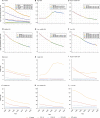Global Burden and Trends of Norovirus-Associated Diseases From 1990 to 2019: An Observational Trend Study
- PMID: 35784210
- PMCID: PMC9247406
- DOI: 10.3389/fpubh.2022.905172
Global Burden and Trends of Norovirus-Associated Diseases From 1990 to 2019: An Observational Trend Study
Abstract
Introduction: As an important pathogen causing diarrheal diseases, the burden and change in the death rate of norovirus-associated diseases (NADs) globally are still unknown.
Methods: Based on global disease burden data from 1990 to 2019, we analyzed the age-standardized death rate (ASDR) of NADs by age, region, country, and Socio-Demographic Index (SDI) level. The discrete Poisson model was applied in the analysis of NADs' spatiotemporal aggregation, the Joinpoint regression model to analyze the trend of death burden of NADs over 30 years, and a generalized linear model to identify the risk factors for the death rate from NADs.
Results: The ASDR of NADs significantly decreased by a factor of approximately 2.7 times, from 5.02 (95% CI: 1.1, 11.34) in 1990 to 1.86 (95% CI: 0.36, 4.16) in 2019 [average annual percent change (AAPC) = -3.43, 95% CI: -3.56, -3.29]. The death burden of NADs in 2019 was still highest in African regions despite a great decline in recent decades. However, the ASDR in high SDI countries presented an uptrend [0.12 (95% CI: 0.03, 0.26) in 1990 and 0.24 (95% CI: 0.03, 0.53) in 2019, AAPC = 2.52, 95% CI: 2.02-3.03], mainly observed in the elderly over 70 years old. Compared to children under 5 years old, the 2019 death rate of elderly individuals over 80 years old was much higher in high SDI countries. The generalized linear model showed that factors of the number of physicians (RR = 0.67), the proportions of children under 14 years old (RR = 1.21), elderly individuals over 65 years old (RR = 1.13), educational level (RR = 1.03) and urbanization proportion (RR = 1.01) influenced the ASDR of NADs.
Conclusions: The death burden of NADs has remained high in developing regions over the last three decades and has increased among the elderly in countries with high SDI levels, even though the global trend in NAD-associated deaths has decreased significantly in the past three decades. More effective public health policies against NADs need to be implemented in high SDI regions and for the elderly.
Keywords: Global Burden of Disease; death rate; epidemic features; global trend analysis; norovirus-associated diseases.
Copyright © 2022 Zhang, Chen, Du, Yan, Jiang, Liu, Yang, Ding, Lan, Hecht and Yang.
Conflict of interest statement
The authors declare that the research was conducted in the absence of any commercial or financial relationships that could be construed as a potential conflict of interest.
Figures



Similar articles
-
Global burden and trends of rotavirus infection-associated deaths from 1990 to 2019: an observational trend study.Virol J. 2022 Oct 20;19(1):166. doi: 10.1186/s12985-022-01898-9. Virol J. 2022. PMID: 36266651 Free PMC article.
-
Global burden and trends of the Entamoeba infection-associated diseases from 1990 to 2019: An observational trend study.Acta Trop. 2023 Apr;240:106866. doi: 10.1016/j.actatropica.2023.106866. Epub 2023 Feb 18. Acta Trop. 2023. PMID: 36801451
-
PM2.5-Related Neonatal Infections: A Global Burden Study from 1990 to 2019.Int J Environ Res Public Health. 2022 Apr 28;19(9):5399. doi: 10.3390/ijerph19095399. Int J Environ Res Public Health. 2022. PMID: 35564793 Free PMC article.
-
The Burden of Trachea, Bronchus, and Lung Cancer Attributable to Occupational Exposure From 1990 to 2019.Front Public Health. 2022 Jun 17;10:928937. doi: 10.3389/fpubh.2022.928937. eCollection 2022. Front Public Health. 2022. PMID: 35784215 Free PMC article.
-
Nanotechnology Lighting the Way for Gene Therapy in Ophthalmopathy: From Opportunities toward Applications.Molecules. 2023 Apr 15;28(8):3500. doi: 10.3390/molecules28083500. Molecules. 2023. PMID: 37110734 Free PMC article. Review.
Cited by
-
Contamination source identification for the prompt management of a gastroenteritis outbreak caused by norovirus in drinking water in Northern Italy.Heliyon. 2024 Jun 10;10(12):e32767. doi: 10.1016/j.heliyon.2024.e32767. eCollection 2024 Jun 30. Heliyon. 2024. PMID: 38975098 Free PMC article.
-
Metagenomic analysis and genomic characterization of enterovirus A76 and Norovirus GI.6[P11] co-infection in a patient with acute gastroenteritis in Thailand.Sci Rep. 2025 Aug 21;15(1):30672. doi: 10.1038/s41598-025-16816-6. Sci Rep. 2025. PMID: 40835708 Free PMC article.
-
Development and evaluation of a new luciferase immunosorbent assay to detect GII.6 norovirus-specific IgG in different domestic and wild animals.Front Microbiol. 2023 Jul 20;14:1213007. doi: 10.3389/fmicb.2023.1213007. eCollection 2023. Front Microbiol. 2023. PMID: 37547694 Free PMC article.
-
Global burden and trends of norovirus-associated diseases from 1990 to 2021 an observational trend study.Front Public Health. 2025 Jan 7;12:1483149. doi: 10.3389/fpubh.2024.1483149. eCollection 2024. Front Public Health. 2025. PMID: 39839433 Free PMC article.
-
Wastewater-based surveillance as a tool for public health action: SARS-CoV-2 and beyond.Clin Microbiol Rev. 2024 Mar 14;37(1):e0010322. doi: 10.1128/cmr.00103-22. Epub 2023 Dec 14. Clin Microbiol Rev. 2024. PMID: 38095438 Free PMC article. Review.
References
-
- Murray CJ, Vos T, Lozano R, Naghavi M, Flaxman AD, Michaud C, et al. . Disability-Adjusted life years (DALYs) for 291 diseases and injuries in 21 regions, 1990-2010: a systematic analysis for the global burden of disease study 2010. Lancet. (2012) 380:2197–223. 10.1016/S0140-6736(12)61689-4 - DOI - PubMed
-
- Lozano R, Naghavi M, Foreman K, Lim S, Shibuya K, Aboyans V, et al. . Global and regional mortality from 235 causes of death for 20 age groups in 1990 and 2010: a systematic analysis for the global burden of disease study 2010. Lancet. (2012) 380:2095–128. 10.1016/S0140-6736(12)61728-0 - DOI - PMC - PubMed
Publication types
MeSH terms
LinkOut - more resources
Full Text Sources
Medical
Research Materials
Miscellaneous

